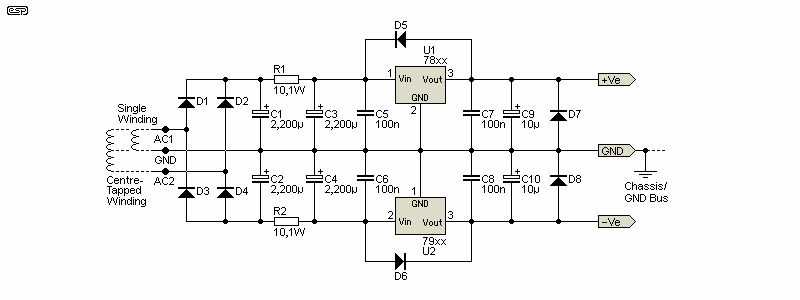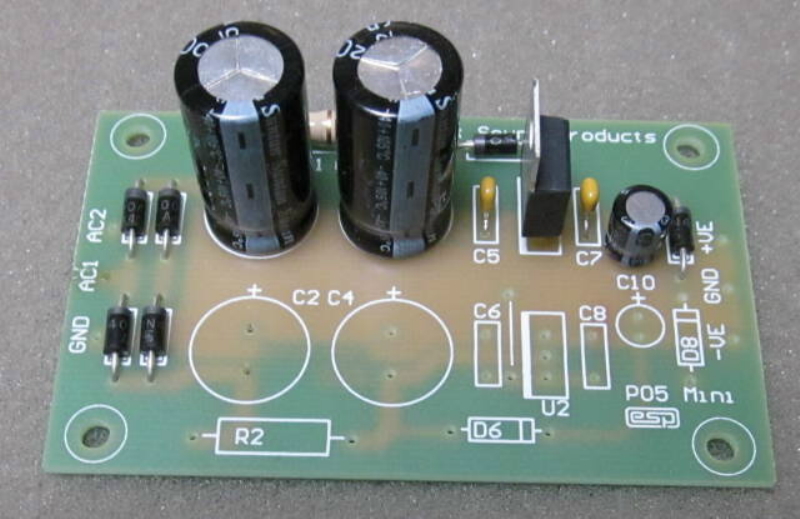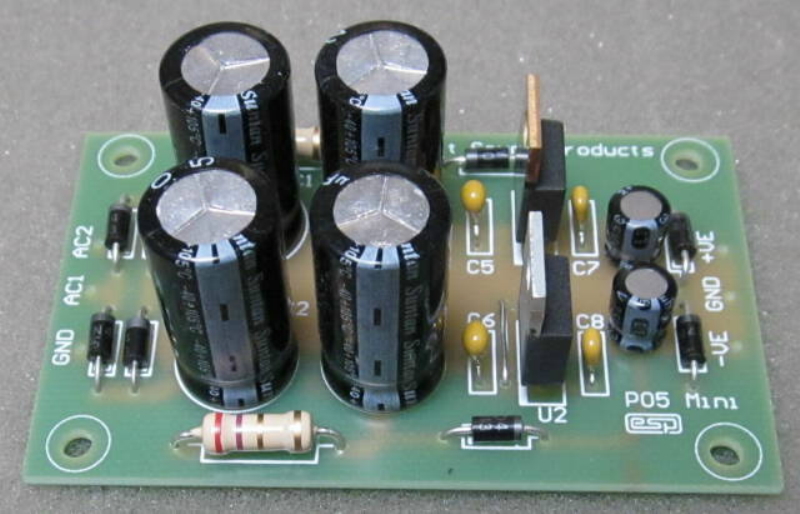

|
| Elliott Sound Products | Project 05-Mini |

| Please Note: PCBs are available for this project. Click the image for details. |
The original version of P05 has been around for a very long time now, and the successors (Rev-A, Rev-B, and now Rev-C) are well over two years old as well. Although the performance of the original or the Rev-A was not lacking in any way, Rev-A saw the change to adjustable regulators. This allows greater flexibility (one can easily make a small variable lab supply with that version), and the adjustable regulators have lower noise. The P05-Mini version described here is bare-bones, without the facility for muting, and using fixed regulators for simplicity - it is just a power supply, but is not compromised in this role.
For anyone who feels a burning desire to downgrade their original P05 or P05A/B/C to the P05-Mini, this board is actually shorter and the mounting holes won't align. The new PCB is quite a bit shorter than the original P05, so while it will still fit into the same location, two new mounting holes will be needed. The PCB is single-sided, and is deliberately made smaller to minimise the cost. It's still large enough to allow for plenty of filter capacitance, which helps to ensure very low hum levels.
This unit also makes a handy test supply for the workshop, and due to the low PCB cost it's cheap and easy to build up a couple of supplies for testing and/ or experimenting.
A simple, high performance supply can be built using an external AC power pack (no mains to worry about, and you don't even need a power lead). Plug packs (wall warts, wall transformers) are available in a variety of voltages, and if you can find a 16V AC version, this is ideal. With 16V, you can easily get ±15V DC regulated, using the circuit shown below. If you cannot find a 16V unit, you can use a 12V version instead, but the regulators will have to be changed accordingly to 7812/ 7912 to set the DC to ±12V. The supply can be configured for ±5V, ±12V or ±15V (using 5, 12 or 15V regulators as needed, and with the appropriate transformer.)
Alternatively, the supply can be run from a conventional split voltage transformer (e.g. 15-0-15V AC). It is designed to be as flexible as possible, but with no additional 'bells' or 'whistles' (or muting circuits  ).
).
As always, inclusion of a fuse suitable for the transformer used is highly recommended, and a thermal fuse is a good idea too, since the power transformer may be left on permanently in some installations (wall transformers use a thermal fuse by default, although some cheap ones (from you-know-where) may not). If a power switch is incorporated in the preamp, this can be a simple low voltage type since no mains voltages are present, and can be in either AC input lead (if you use the single winding transformer option) - there is no need to break both leads with the switch. Naturally, if you use a standard transformer it is better to switch the mains to conserve power.
NOTES:

Figure 1 - Preamplifier Power Supply
All component values, bill of materials and comprehensive instructions are made available when you purchase the PCB. If you want to build a supply without purchasing the board, then use the circuit shown above. Naturally, by buying the PCB you are helping to support ESP so I can continue to provide new articles and projects.
If a single AC supply is connected between GND and AC2, the rectifier is a full-wave voltage-doubler type, and with an input of 16VAC will provide about +/-20V DC at a current of up to at least 100mA - this should be enough for the most preamps. All diodes are 1N4004 or similar (400V / 1A rating for all, but 100V diodes can also be used of course).
If a split AC supply is used (such as 15-0-15V AC), then the transformer centre tap connects to GND, and the two 15V winding ends connect to AC1 and AC2. Although virtually any transformer of 0.5A or more will work (provided the voltage is correct), there is very little to be gained by using anything more than 30VA (and even that is likely to be overkill). Note that a transformer rated for a 500mA output current can only provide around 250mA DC (which will draw close to 500mA RMS from the secondary), so it's not uncommon that the transformer needs to be larger than you imagined.
The 3-terminal regulators specified are TO-220 types, and unless your preamp requires lots of current, they will not require a heatsink. If the current drain is such that more than 1V is lost across R1 and/ or R2, reduce the value. The minimum suggested is 1 ohm, but it's unlikely that you'll need less than 2.7 ohms (up to 350mA output current).
The diodes around the regulators prevent reverse voltages being applied to the regulator chips under any condition. They are not strictly necessary, but are considered a good idea. The bypass caps are as close to the IC power leads as possible to prevent oscillation. The two diodes at the outputs ensure that the regulator ICs cannot 'latch-up' with unbalanced output loads or if a voltage is applied to the outputs.
The PCB can be wired to use a single 16V AC supply, or a 15-0-15 AC supply from a conventional centre-tapped power transformer. Or, if you need to, it may be powered directly from an existing source of DC - make sure that the input voltage is below ±30V under all operating conditions - this is important, otherwise the regulators will dissipate too much heat, and may be damaged by over-voltage. For this connection, the rectifier diodes are not essential, but they do provide reverse polarity protection and mean that the supply will work with either DC polarity on AC1 and AC2 (which are now DC inputs).
The maximum output current is determined by several factors. These include the mains transformer and regulator heatsink. The transformer used ultimately is the primary limiting factor, because small transformers usually have poor regulation. This becomes more limiting if you use an external transformer, as the power supply operates as a voltage doubler. The absolute maximum DC output current is (roughly) equal to the transformer current rating, divided by 3.3. A 500mA, 16V (8VA) transformer can therefore deliver no more than 150mA, but with an output current of more than ~50mA you may get some ripple on the regulated DC.
If you use a 500mA 15-0-15V centre-tapped transformer (30VA), the maximum DC output will (in theory) be 270mA, but some ripple breakthrough is almost a certainty with that much current. A safe maximum would be about ±100mA. Larger transformers (whether single or dual winding) will always provide better performance, with less voltage droop at higher currents and less chance of ripple breakthrough.
Ultimately, this is something that you must test yourself, because there are so many variables involved. Not all transformers are created equal, but for most circuits you probably won't need more than 75mA DC or so, simply because opamps don't draw a great deal of current. Even if you use NE5532 opamps, they will generally only draw about 8mA each (although it might be up to 16mA). That's enough to power nine NE5532s, or up to 26 TL072s. Make sure that you check the datasheet(s) for the opamps you intend to use, so you can verify the supply current.
There may be occasions where you need a single supply - this will most commonly be +5V, but other voltages are equally possible. While it may seem something of a waste to use the dual supply board for a single supply, it's cost effective and gives very good performance. For a single supply, simply omit all the parts used for the polarity you don't need. Most commonly this will be the negative side, so C2, R2, C4, U2 (etc.) are omitted.
You will still need the four rectifier diodes (D1-D4) and a link may be installed in place of C2 for use with a single winding transformer. If you don't include the link, the supply will not work. AC must be applied to AC1 and AC2, with no transformer winding connected to the GND terminal. Be very careful if you use a shared transformer (with 2 boards providing ±15V and +5V for example), as the single +ve supply must not have the C2 link installed.
If you have a transformer with a centre-tapped winding, the CT is connected to GND and the other outputs to AC1 and AC2. In this case, do not install the link across C2 or you may destroy the transformer! The rectifier is then a 'conventional' full-wave type, and two of the diodes (D3 and D4) are redundant.

Figure 2 - Single Supply Version
The single supply version is shown set up to use a centre tapped transformer. D3 and D4 can be omitted when used this way, as they don't do anything. In both of these, I used a 33µF cap instead of 10µF at the regulator outputs, for no reason other than that a bag of them was on my workbench at the time of assembly. It makes little or no difference to performance.

Figure 3 - Dual Supply Version
The dual supply version is exactly as shown in the schematic, except that R1 and R2 are 2.7 ohms instead of 10 ohms. These supplies are now both in a case that provides ±15V and +5V so I can run tests in my office, where I can use my PC based test gear rather than in the workshop with 'real' test equipment. Having such a test supply available is always useful, and it certainly won't be wasted  .
.
After assembly, the supply must be tested to ensure that there are no wiring errors. If you have a suitable bench power supply this can be used, but some builders will not have access to one. If you do not have a bench power supply, use the following method.
For testing, you will need one (or two for a centre tapped transformer) 22 ohm 5W resistors.
Before power is first applied, temporarily install the 22 Ohm wire wound 'safety' resistor(s) in series with the AC to the supply. Do not connect a load at this time!
With a multimeter connected to the supply output, apply power. The voltage should come up to the full supply voltage (±15V or other voltage set by the regulators used). If not, remove power immediately (the resistors will get hot) - it is probable that you have made a mistake, so find and correct it and try again. The most common errors are solder bridges, 'dry'/ 'cold' solder joints, or parts installed incorrectly.
When the supply is working to your satisfaction, remove the safety resistor(s) and connect the transformer permanently.
NOTES
 Main Index
Main Index
 Projects Index
Projects Index